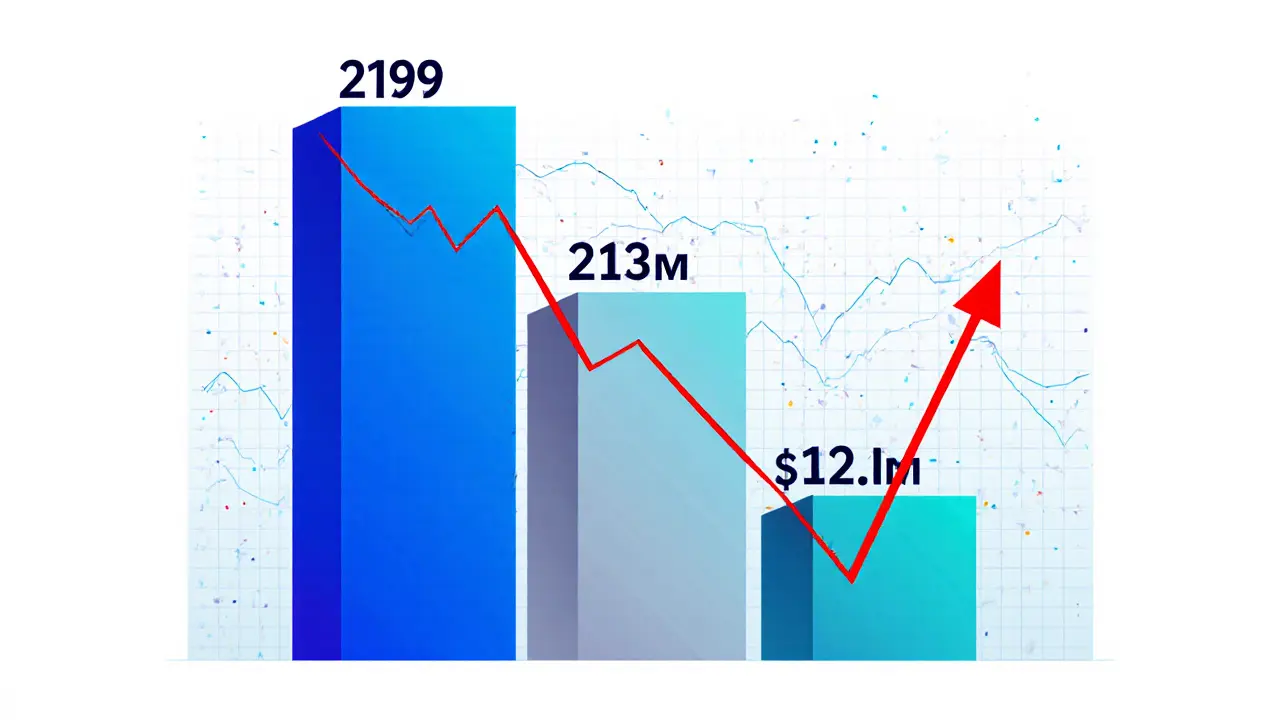Sep 7, 2025, Posted by: Ronan Caverly

Coinbit Trading Volume Analyzer
Key Takeaways
- Coinbit, a South Korean exchange launched in 2018, suffers from chronic liquidity problems.
- Trading volume peaked at $313million daily in March2020 and fell to under $100 by the end of 2021.
- Security is decent, but limited pair selection and high slippage hurt traders.
- Compared with Binance, Kraken and Coinsbit, Coinbit lags in depth, community, and market‑making.
- Without a major strategic overhaul, long‑term sustainability looks doubtful.
If you’ve typed “Coinbit crypto exchange review” into a search box, you probably want to know whether the platform is worth your time or money. In the next few minutes we’ll walk through the exchange’s backstory, its current health, and how it measures up against the big players you might already be using. No fluff-just the facts you need to decide if you should open an account.
When talking about South Korean crypto platforms, Coinbit is a cryptocurrency exchange operated by Axia Inc. out of Seoul. The company launched in July2018 under CEO HyunBaek Park and offers Korean, Japanese, Chinese and English interfaces.
History and Ownership
Coinbit emerged during a boom in South Korean digital‑asset trading. Axia Inc. positioned the exchange around four promises: security, convenience, speed, and an “exciting” trading experience. Early marketing material highlighted a sleek UI and rapid order execution, aiming to attract retail traders hungry for altcoins.
The platform’s timeline can be summed up in three phases:
- Launch (2018‑2019): modest daily volume around $1.8million; limited liquidity but a growing user base.
- Surge (2020): a dramatic spike to $313million in 24‑hour volume on March212020, driven by market hype and a brief influx of Korean traders.
- Collapse (2021‑2025): volume slumped to under $86 by December2021 and has hovered in the double‑digit range ever since.
This roller‑coaster suggests that coin‑bit’s growth was not backed by sustainable market‑making, making it vulnerable to sudden sell‑offs.
Liquidity and Trading Volume
Liquidity is the lifeblood of any exchange. Without enough buyers and sellers, orders slip, spreads widen, and traders lose money before a trade even fills. Coinbit’s publicly available volume data tells a stark story.
| Date | Volume | Notes |
|---|---|---|
| April22019 | $1.8million | Early adoption period |
| March212020 | $313million | Peak - 17,300% increase |
| December22021 | $85.89 | Liquidity crisis |
| Oct2025 (latest) | ≈ $120 | Stagnant, minimal order book |
Even if you ignore the outlier spike, daily volume under $2million is low for a market that serves a country with one of the world’s highest crypto retail participation rates. The drop means users face high slippage-buying a coin at $10 may actually fill at $10.30 or more because the order book is thin.
Security, Features, and User Experience
Security-wise, Coinbit employs standard industry measures: two‑factor authentication, SSL encryption, and cold‑wallet storage for the majority of assets. No major hacks have been reported, which matches the claim that the exchange is “secure.” However, security alone doesn’t attract traders if the platform can’t execute orders efficiently.
Feature set includes:
- Spot trading for a limited set of major pairs (BTC, ETH, KRW‑denominated altcoins).
- Basic charting tools; no advanced order types (no stop‑limit, OCO, etc.).
- Mobile app (separate from the CoinBit tracking app) that mirrors the web UI.
- English & Korean language support; Japanese and Chinese added later.
The lack of advanced trading options and low pair count makes the platform feel “bare‑bones” compared with rivals that offer futures, margin, staking, and DeFi integrations.

How Coinbit Stacks Up Against the Competition
To see where Coinbit really stands, let’s line it up with three well‑known exchanges: Binance, Kraken, and the unrelated Coinsbit platform (often confused with Coinbit).
| Feature | Coinbit | Binance | Kraken | Coinsbit |
|---|---|---|---|---|
| Daily Volume (USD) | ≈ $120 | $35billion | $1.2billion | $150million |
| Number of Trading Pairs | ~30 | ~1,200 | ~250 | ~600 |
| Advanced Orders (stop‑limit, OCO) | No | Yes | Yes | Yes |
| Staking / IEO | No | Yes | Yes | Yes |
| Regulatory Compliance (KYC/AML) | Basic | Comprehensive | Comprehensive | Basic |
| Community Presence (Reddit, Trustpilot) | Very low | High | High | Low‑Medium |
The numbers speak for themselves: Coinbit’s volume and pair count are an order of magnitude smaller than even the “low‑end” competitor Coinsbit. Binance dominates with deep liquidity, while Kraken offers strong compliance for institutional traders. If you value a vibrant community and robust tools, Coinbit simply doesn’t measure up.
User Feedback and Community Signals
One way to gauge an exchange’s health is by looking at user reviews. Searches on Reddit, Trustpilot, and major crypto forums return almost no discussion about Coinbit. The silence suggests either a tiny user base or a community that prefers not to talk about the platform-both red flags.
By contrast, Binance and Kraken each host thousands of threads, ranging from troubleshooting to advanced strategy sharing. This active dialogue creates a feedback loop that helps those exchanges improve security, add features, and address bugs quickly.
Regulatory Landscape in South Korea
South Korea’s crypto regulations are among the world’s strictest: exchanges must register with the Financial Services Commission, enforce real‑name verification, and adhere to robust AML policies. Axia Inc. has complied enough to operate, but the market‑share data shows that larger, regulated players like Upbit and Bithumb dominate the Korean scene.
The regulatory pressure also means that any exchange with weak liquidity can become a target for enforcement if it cannot demonstrate adequate market‑making or consumer protection. At present, there are no public penalties against Coinbit, but the lack of growth under regulatory scrutiny hints at limited appetite from both users and regulators.
Future Outlook and Strategic Options
What could turn Coinbit’s fortunes around? Analysts from Cryptowisser note three potential paths:
- Strategic partnership: Align with a larger exchange for shared liquidity pools.
- Feature expansion: Add staking, futures, and a robust API to attract traders.
- Geographic focus: Double down on a niche market (e.g., Korean indie projects) where competition is lower.
Each option requires significant capital and a clear roadmap. Without such moves, the exchange risks becoming a “ghost” platform-still online but rarely used.
Bottom Line for Readers
If you’re hunting for a place to trade major cryptocurrencies with deep order books, low fees, and solid community support, Coinbit is not the answer. Its liquidity is thin, its feature set basic, and its user base practically invisible. For Korean traders who need a local interface and are willing to accept higher slippage, it could serve as a backup, but even there the risks outweigh the benefits.
For most investors, sticking with Binance, Kraken, or a well‑established regional player like Upbit will deliver a smoother, safer experience. Keep an eye on any announcements from Axia Inc.-a major partnership could change the equation, but until then, treat Coinbit with caution.

Frequently Asked Questions
Is Coinbit safe to use?
Coinbit employs standard security measures like 2FA and cold‑wallet storage, and there have been no major hacks reported. However, safety also depends on liquidity and market‑making; thin order books mean you could face high slippage or incomplete fills, which is a form of risk.
How does Coinbit’s trading fee compare to Binance?
Coinbit charges a flat 0.25% maker/taker fee on most pairs, which is slightly higher than Binance’s 0.10%‑0.15% tiered fee structure for equivalent volume levels. The fee difference is modest, but the real cost comes from slippage on low‑liquidity trades.
Can I trade fiat on Coinbit?
Coinbit primarily offers KRW‑based pairs for Korean users. It does not provide a broad range of fiat gateways like USD, EUR, or GBP that you find on Binance or Coinbase.
What is the biggest drawback of using Coinbit?
The lack of liquidity is the most critical issue. Thin order books lead to high slippage, price manipulation risk, and delayed order execution, making it unsuitable for sizable trades.
Is Coinbit regulated in South Korea?
Yes, Axia Inc. has registered the exchange with the Financial Services Commission and complies with basic KYC/AML requirements. The regulatory framework, however, is stricter than in many other jurisdictions, and compliance adds operational overhead.
Write a comment
Comments
Jeannie Conforti
Hey, if you’re just getting started with crypto, keep an eye on the spread – thin books like Coinbit can turn a small trade into a bigger cost.
September 7, 2025 AT 16:46
tim nelson
I get why some traders keep Coinbit as a backup, but the slippage you’ll see on a $500 move can easily eat half your profit.
September 8, 2025 AT 04:58
Zack Mast
Liquidity isn’t just a number; it’s the trust you place in an exchange to execute orders at the price you see. Coinbit’s dip to $120 M daily volume makes that trust shaky, especially when market makers have fled. One could argue the Korean market still needs a domestic player, yet without deep order books the platform becomes a price‑impact hazard. The security measures are solid, but security alone won’t stop a 30 % slip on a modest trade. In short, think twice before committing more than a few thousand dollars there.
September 8, 2025 AT 17:11
Dale Breithaupt
Nice point about liquidity.
September 9, 2025 AT 05:23
Rasean Bryant
There’s still a place for Coinbit if you’re only swapping small amounts of KRW‑based tokens; the fees stay low and the UI is user‑friendly.
September 9, 2025 AT 17:36
Angie Food
Honestly, the whole thing feels like a ghost exchange that forgot how to attract real traders.
September 10, 2025 AT 05:48
Jonathan Tsilimos
From a macro‑economic perspective, the absence of diversified market‑making algorithms on Coinbit contributes to elevated bid‑ask spreads, thereby diminishing the platform’s competitive edge relative to tier‑1 venues. Moreover, the limited instrument suite curtails hedging opportunities for institutional participants.
September 10, 2025 AT 18:01
jeffrey najar
If you decide to test the waters, start with the minimum trade size and monitor order‑book depth in real time; that’ll give you a practical sense of the slippage risk before scaling up.
September 11, 2025 AT 06:13
Rochelle Gamauf
While the security architecture adheres to industry standards, the paucity of liquidity fundamentally undermines the exchange’s value proposition, rendering it unsuitable for substantive portfolio rebalancing.
September 11, 2025 AT 18:26
Jerry Cassandro
Looking at the data, the daily volume has plateaued at roughly $120 M, which is a stark contrast to Binance’s multi‑billion throughput; that discrepancy alone explains the wider spreads you’ll encounter.
September 12, 2025 AT 06:38
Parker DeWitt
Coinbit tries to look modern 😎 but the thin order book says otherwise 📉.
September 12, 2025 AT 18:51
Allie Smith
In the grand scheme, a platform that can’t sustain its own order flow mirrors a ship without wind – it may look fine on the deck but never truly moves forward.
September 13, 2025 AT 07:03
Lexie Ludens
It’s almost tragic how an exchange with decent security can become a wasteland of price manipulation, leaving users to wander in a desert of low liquidity.
September 13, 2025 AT 19:16
Aaron Casey
From a compliance lens, Coinbit meets basic KYC/AML, yet the systemic liquidity shortfall raises concerns about market integrity and potential regulatory scrutiny.
September 14, 2025 AT 07:28
Leah Whitney
For newcomers who prefer a Korean interface, Coinbit can serve as a stepping stone, provided you stay aware of the higher transaction costs stemming from limited depth.
September 14, 2025 AT 19:41
Lisa Stark
Reflecting on the trade‑off, the convenience of a localized UI must be weighed against the operational risk of thin markets, especially for larger position sizing.
September 15, 2025 AT 07:53
Logan Cates
Sure, Coinbit is “the underdog,” but sometimes the underdog is just a tired dog that can’t keep up.
September 15, 2025 AT 20:06
Shelley Arenson
👍 Good to know the basics.
September 16, 2025 AT 08:18
Joel Poncz
i think if you keep your trades small and avoid volatile altcoins, coinbit might actually work for you.
September 16, 2025 AT 20:31
Kris Roberts
The experience on a low‑liquidity exchange often feels like shouting into an empty room; the echo is the price impact you’re forced to accept.
September 17, 2025 AT 08:43
lalit g
From an Indian perspective, the limited pair selection on Coinbit makes it less appealing compared to global platforms that offer direct INR bridges.
September 17, 2025 AT 20:56
Reid Priddy
While some praise the security, the persistent liquidity vacuum suggests a deeper systemic issue that cannot be ignored.
September 18, 2025 AT 09:08
Shamalama Dee
Remember, diversification across exchanges can mitigate the risks posed by any single platform’s liquidity constraints.
September 18, 2025 AT 21:21
scott bell
When you first glance at Coinbit’s interface you might think you’ve found a neat local alternative, but the deeper you dig the more the cracks appear. The daily volume hovering around $120 M tells a story of an order book that’s too shallow to handle even modest swings. Traders who place a $5 k order often see it filled at a price 0.3 % worse than expected, which translates into a hidden fee far higher than the listed 0.25 % maker‑taker rate. That slippage becomes a silent eroder of profits, especially for day‑traders who rely on tight spreads. Moreover, the lack of advanced order types such as stop‑limit or OCO forces users to monitor positions manually, increasing operational overhead. Security measures like 2FA and cold‑wallet storage are commendable, yet they cannot compensate for a market that can be easily manipulated. Without a robust market‑making partner, the exchange becomes vulnerable to wash‑trading and price spikes that can trigger margin calls. The community presence is practically nonexistent; a quick search yields only a handful of Reddit comments, a sign that users have either moved on or never fully trusted the platform. Regulatory compliance is merely a checkbox in South Korea, and while Coinbit meets the basic KYC requirements, it lacks the depth of audit trails seen on larger exchanges. Investors looking for long‑term stability should consider the opportunity cost of keeping funds idle on a platform that offers little growth potential. On the other hand, for a Korean user needing a simple KRW‑based gateway, Coinbit might still serve a niche purpose if used sparingly. The strategic options outlined-partnering with a larger exchange, expanding feature sets, or focusing on niche markets-are all plausible paths, but each demands capital and clear execution. Until such moves materialize, the safest advice remains to treat Coinbit as a secondary or backup venue rather than a primary trading hub. In summary, the exchange’s security is solid, its UI is user‑friendly, but the liquidity void makes it a risky core platform for serious traders.

Author
Ronan Caverly
I'm a blockchain analyst and market strategist bridging crypto and equities. I research protocols, decode tokenomics, and track exchange flows to spot risk and opportunity. I invest privately and advise fintech teams on go-to-market and compliance-aware growth. I also publish weekly insights to help retail and funds navigate digital asset cycles.